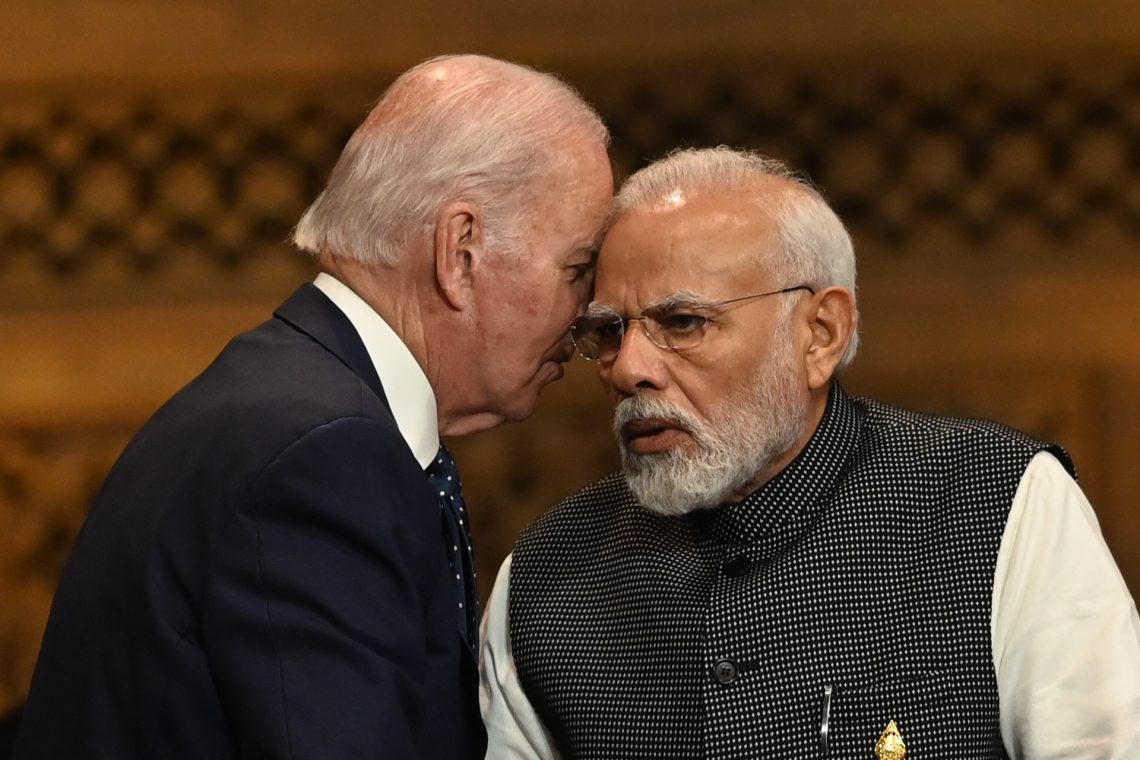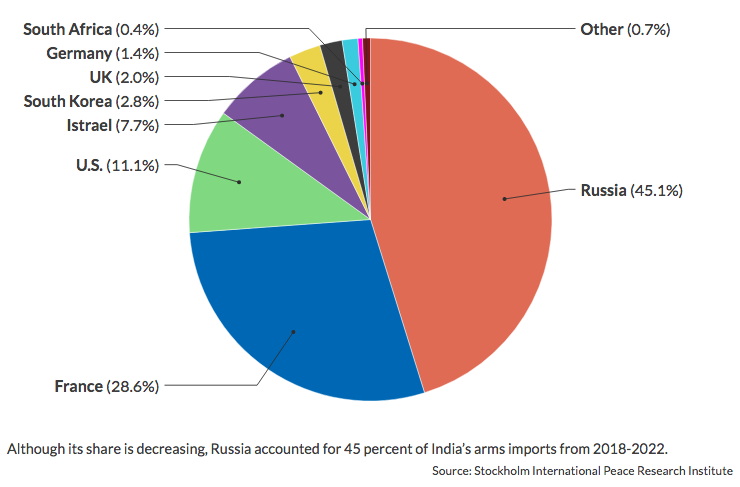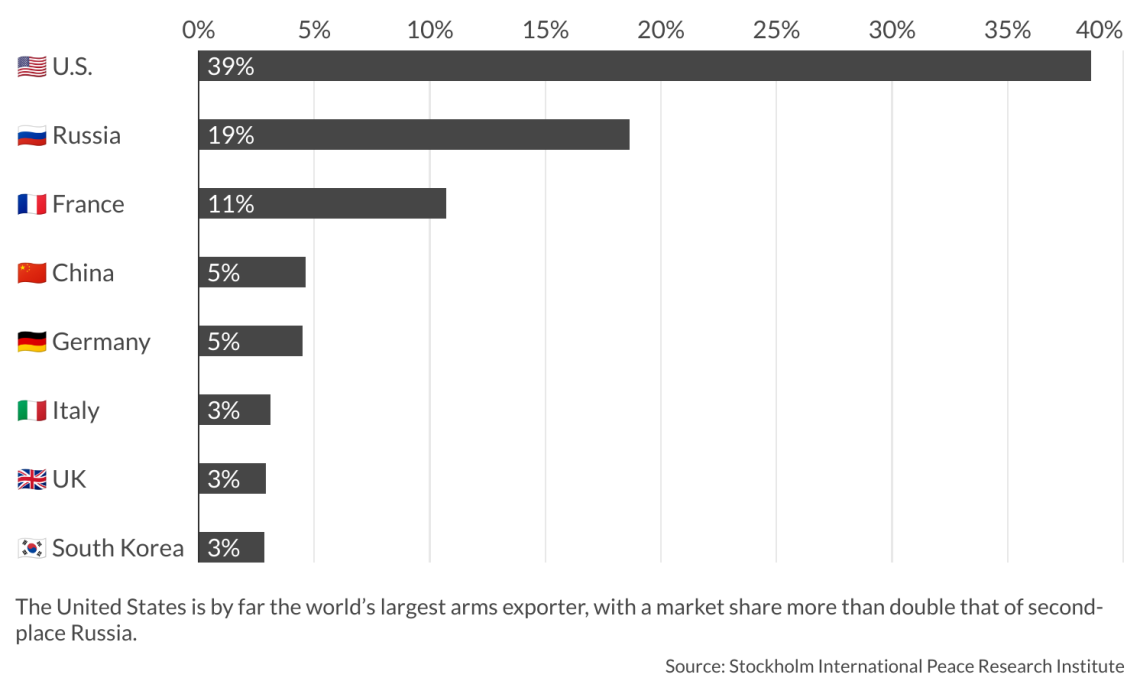India tilts West as Russian ties cool
With China and Russia tightening their alliance, India is reacting by improving its ties with the United States, Europe and other Asian nations.

In a nutshell
- India will cut dependence on Russia for weapons, but not energy
- New Delhi will seek to remain a nonaligned Global South leader
- The U.S. and India are cooperating more closely on China policy
The United States envisions cooperation with India as crucial to helping ease Washington’s concerns over the destabilizing activities of China in the Indo-Pacific. The U.S. also sees Russia as a strategic threat. India, however, has a historic and enduring relationship with Russia. Russia is a significant exporter of arms, about $13 billion in the last five years, and oil, about 1.6 million barrels per day in February, to India. With Russia’s ever-closer relationship with China, the U.S. evaluates the long-term prospects for Indian-Russian relations and how they might affect cooperation with India in responding to mutual concerns.
The nature of Indian-Russian ties
During the Cold War, U.S.-Indian relations were strained over the Indian nuclear weapons program and close American ties with Pakistan, with which India has territorial disputes that erupted into armed conflict. U.S. sanctions led India to turn to Russia as its principal arms supplier. In addition, New Delhi emerged as the global nonaligned movement leader. While the movement purported to eschew choosing sides in the Cold War, the Soviets actively supported it. Further, many Indians went to Russia for advanced military, scientific and public education.
In recent years, India has developed much closer ties with America. The nation sees American power and influence as key in balancing the rise of China in the Indo-Pacific. The capstone of cooperation emerged in establishing the Quad, a joint Indian, U.S., Australian and Japanese forum aimed at promoting a free and open Indo-Pacific and managing the security challenge from China. Nevertheless, India continues to have strong economic, diplomatic and military ties with Russia.
The challenge of Chinese-Russian cooperation
A complicating factor for India’s strategy is the continuing alignment of Russia and China. Moscow has turned to China for support because of the Kremlin’s isolation from the West over its war on Ukraine. China is also a chief customer of Russian energy. In addition, Russia has requested military aid from China, part of a “no-limits” partnership declared by Presidents Xi Jinping and Vladimir Putin.
A Sino-Russian bloc represents a strategic dilemma for India, particularly with Moscow as the junior partner. What is to prevent Beijing from using its leverage over the Kremlin to pressure India?
More on India
As Russia’s war grinds on, India-U.S. relations set to strengthen
Strains in the security partnership
Energy supplies are not the root cause of India’s challenge. The nation is determined to press ahead with economic growth and will not limit its energy imports. When the U.S. pressed sanctions on Iranian energy, New Delhi complied because the U.S. actively worked with the Indians to ensure the shortfalls from Iranian imports were replaced. While sanctions were imposed on Russia, the U.S. quietly told India that Washington had no objections to it continuing to import Russian oil.
The crucial issue is arms imports. Before the war in Ukraine, 60 percent of India’s arms imports were from Russia. Moscow still leads, but its share has dropped to 45 percent.
The nation had been looking to diversify military suppliers even before Russia’s invasion. While Russian arms are often considered inexpensive, the life-cycle costs of repair, maintenance, logistics and spare parts can be high, making Russian weapons more expensive in the long term. In addition, Russian arms are increasingly viewed as being of lesser quality than arms available from Western suppliers. Closer partnerships with the U.S., Europe and Israel allow India to diversify its arms supply. Today, India accounts for about 9.5 percent of global arms imports. In addition, the nation is looking to build up its domestic arms industry both for its use and export.
The war in Ukraine has only exacerbated the challenges of reliance on Russian arms. Today, Russian arms manufacturers are under sanctions and Russia must also divert much of its weapons production to replace combat losses. There is already some evidence that the Russians are falling behind in providing deliveries and support for Indian military contracts. Reuters on March 23 reported that “Russia is unable to deliver vital defense supplies it had committed to India’s military because of the war in Ukraine, the Indian Air Force (IAF) says.” By some estimates, it will take the Russians three to seven years to replace all their lost systems. That could mean long-term shortages for customers such as India.
Finally, Russian equipment has performed poorly in Ukraine, making Russian arms less desirable. An Indian think tank with close ties to the current government, the Vivekananda International Foundation, recently concluded in a report that the quality of Russian technology “is increasingly being questioned,” especially considering Western sanctions against Moscow. “In the long term, India must work toward weaning itself away from dependence on Russia for military technology.”
Facts & figures
Diplomacy and partnership
So far, India has assiduously sought to refrain from criticizing Russia’s war in Ukraine. Yet Russia and China recently embarrassed India, the chair of the G20 this year, by rejecting a consensus statement on the war in Ukraine at a recent assembly of foreign ministers. Meanwhile, India is promoting itself as a leader in the Global South, competing for influence with Moscow and Beijing, and India has also rejected China’s Belt and Road Initiative.
India remains an enthusiastic member of the BRICS economic grouping that includes China, Russia, South Africa and Brazil. These conflicting diplomatic initiatives could reflect the tension between India’s quest for nonaligned leadership and the reality of rising to the global challenge of China.
India has also made ambitious outreach efforts in the Pacific to Japan and Taiwan, in the Middle East, particularly to Israel, Turkey and the Gulf states, and Western Europe. For instance, Italian Prime Minister Giorgia Meloni was recently in New Delhi. These efforts are particularly noteworthy since they affect India’s status in the Indo-Pacific and its connections with the West. India wants to decrease its dependence on trade with China. It cannot reach markets and suppliers to the north because it has no routes through Afghanistan and Pakistan. Routing through Iran, Armenia and Russia looks increasingly problematic. India’s natural corridor to the West is through the Middle East to the Eastern Mediterranean, entering Europe, the Caucasus and Central Asia. This also increases India’s interest in East Africa. All this geopolitical connectivity puts India at odds with China and Russia.
Facts & figures
Scenarios
India has one of the world’s fastest-growing economies and has eclipsed China as the most populous nation. Yet the country is not strong or wealthy enough to be considered an independent superpower. China will remain its top strategic rival, with the chances of detente slim. Meanwhile, as China supplants Russian power and influence, a partnership with Moscow will offer India fewer strategic advantages. As younger generations assume more leadership and responsibility, the weight of historic ties with Russia will diminish. Finally, as Russia grows more dependent on China, Moscow will become a less trusted ally for New Delhi.
The confluences of these strategic trends suggest that Russian-Indian cooperation will be less of a factor in the future. While India will not soon shed its strong diplomatic tradition of nonalignment, it will increasingly shift to collaboration with those nations that can help assure a free and open Pacific and India’s connectivity to the rest of the world. This group will likely include Israel, the Gulf states, Turkey, Europe, Australia, the Philippines, Taiwan, Japan, South Korea and the U.S.
It is unlikely that India will seek to promote to Russia its Western ties to split the Russian-China detente. The Indians already know that effort is a lost cause. Indeed, New Delhi will prioritize cooperation with the West.
From a U.S. perspective, Russian-Indian relations will not be seen as any strategic risk or an impediment to closer cooperation between Washington and New Delhi. Both the U.S. and India will prioritize the China challenge. It is doubtful that the U.S. will press India on Russia or maintain that Moscow’s close relationship with Beijing threatens it. Washington will let New Delhi come to that conclusion on its own. Expect the U.S. to continue to seek stronger bilateral ties.











